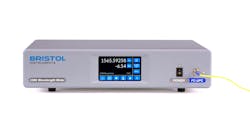Bristol Instruments unveils 338 Series Optical Wavelength Meter for optical transceiver testing
Bristol Instruments has introduced the 338 Series Optical Wavelength Meter for optical transceiver testing applications. The company says the 338 Series offers a measurement rate of 25 Hz, which will enable greater production throughput, according to Bristol.
The low-cost optical wavelength meter leverages Michelson interferometer-based technology with fast Fourier transform analysis to measure the wavelength of CW or modulated signals to an accuracy of ±1.0 pm. The unit features continuous calibration with a built-in wavelength standard to ensure reliable test results. Technicians can control the system via a touch-screen display that also shows the wavelength and power measurements in a variety of formats. Data also can be sent to a PC using a library of SCPI commands via USB, Ethernet, or GPIB.
“The 338 Optical Wavelength Meter is designed to improve the efficiency of optical transceiver wavelength testing,” commented Dr. Brian Samoriski, vice president of sales and marketing at Bristol Instruments. “This new product demonstrates our dedication to satisfying the needs of our customers.”
For related articles, visit the Test and Measurement Topic Center.
For more information on test instruments and suppliers, visit the Lightwave Buyer’s Guide.
To stay abreast of optical communications technology, subscribe to Lightwave’s Enabling Technologies Newsletter.

Stephen Hardy | Editorial Director and Associate Publisher, Lightwave
Stephen Hardy is editorial director and associate publisher of Lightwave and Broadband Technology Report, part of the Lighting & Technology Group at Endeavor Business Media. Stephen is responsible for establishing and executing editorial strategy across the both brands’ websites, email newsletters, events, and other information products. He has covered the fiber-optics space for more than 20 years, and communications and technology for more than 35 years. During his tenure, Lightwave has received awards from Folio: and the American Society of Business Press Editors (ASBPE) for editorial excellence. Prior to joining Lightwave in 1997, Stephen worked for Telecommunications magazine and the Journal of Electronic Defense.
Stephen has moderated panels at numerous events, including the Optica Executive Forum, ECOC, and SCTE Cable-Tec Expo. He also is program director for the Lightwave Innovation Reviews and the Diamond Technology Reviews.
He has written numerous articles in all aspects of optical communications and fiber-optic networks, including fiber to the home (FTTH), PON, optical components, DWDM, fiber cables, packet optical transport, optical transceivers, lasers, fiber optic testing, and more.
You can connect with Stephen on LinkedIn as well as Twitter.
